Predicting the impact of border control on malaria transmission: a simulated focal screen and treat campaign
- PMID: 26164675
- PMCID: PMC4499227
- DOI: 10.1186/s12936-015-0776-2
Predicting the impact of border control on malaria transmission: a simulated focal screen and treat campaign
Abstract
Background: South Africa is one of many countries committed to malaria elimination with a target of 2018 and all malaria-endemic provinces, including Mpumalanga, are increasing efforts towards this ambitious goal. The reduction of imported infections is a vital element of an elimination strategy, particularly if a country is already experiencing high levels of imported infections. Border control of malaria is one tool that may be considered.
Methods: A metapopulation, non-linear stochastic ordinary differential equation model is used to simulate malaria transmission in Mpumalanga and Maputo province, Mozambique (the source of the majority of imported infections) to predict the impact of a focal screen and treat campaign at the Mpumalanga-Maputo border. This campaign is simulated by nesting an individual-based model for the focal screen and treat campaign within the metapopulation transmission model.
Results: The model predicts that such a campaign, simulated for different levels of resources, coverage and take-up rates with a variety of screening tools, will not eliminate malaria on its own, but will reduce transmission substantially. Making the campaign mandatory decreases transmission further though sub-patent infections are likely to remain undetected if the diagnostic tool is not adequately sensitive. Replacing screening and treating with mass drug administration results in substantially larger decreases as all (including sub-patent) infections are treated before movement into Mpumalanga.
Conclusions: The reduction of imported cases will be vital to any future malaria control or elimination strategy. This simulation predicts that FSAT at the Mpumalanga-Maputo border will be unable to eliminate local malaria on its own, but may still play a key role in detecting and treating imported infections before they enter the country. Thus FSAT may form part of an integrated elimination strategy where a variety of interventions are employed together to achieve malaria elimination.
Figures
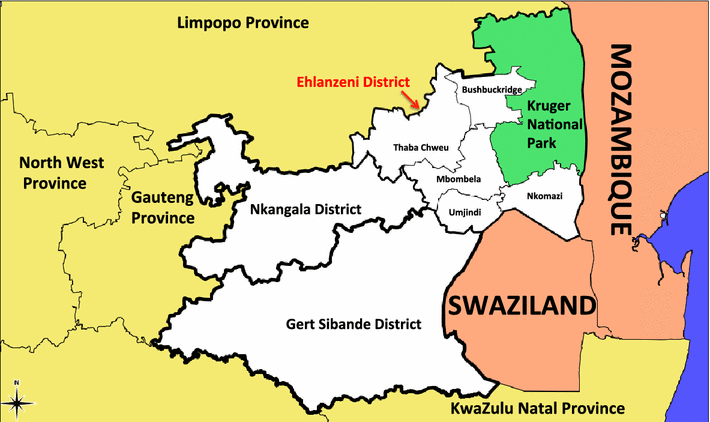
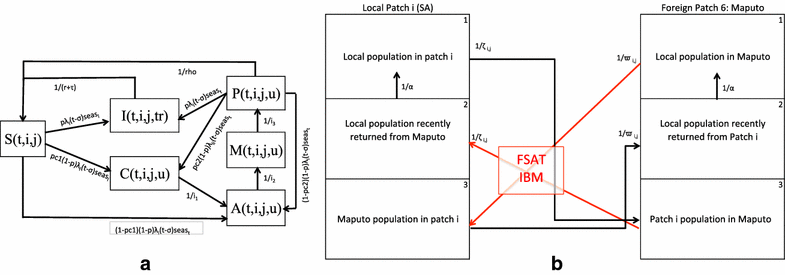
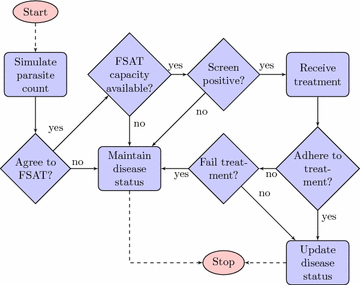

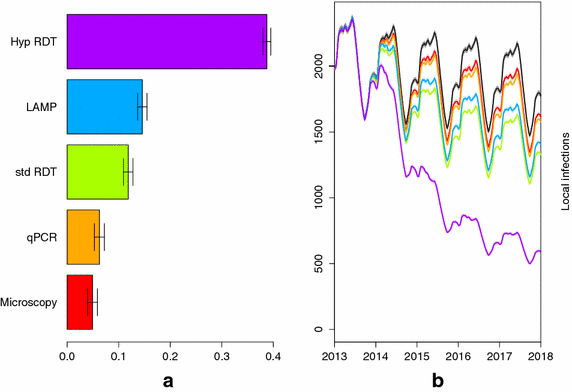
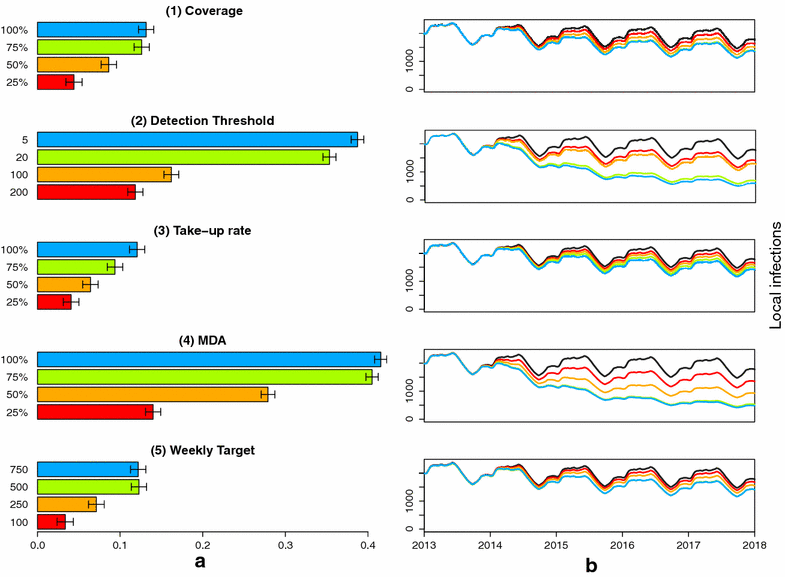
Similar articles
-
Hitting a Moving Target: A Model for Malaria Elimination in the Presence of Population Movement.PLoS One. 2015 Dec 21;10(12):e0144990. doi: 10.1371/journal.pone.0144990. eCollection 2015. PLoS One. 2015. PMID: 26689547 Free PMC article.
-
Towards malaria elimination in Mpumalanga, South Africa: a population-level mathematical modelling approach.Malar J. 2014 Aug 3;13:297. doi: 10.1186/1475-2875-13-297. Malar J. 2014. PMID: 25086861 Free PMC article.
-
Travel patterns and demographic characteristics of malaria cases in Swaziland, 2010-2014.Malar J. 2017 Sep 8;16(1):359. doi: 10.1186/s12936-017-2004-8. Malar J. 2017. PMID: 28886710 Free PMC article.
-
Tackling imported malaria: an elimination endgame.Am J Trop Med Hyg. 2015 Jul;93(1):139-144. doi: 10.4269/ajtmh.14-0256. Epub 2015 May 26. Am J Trop Med Hyg. 2015. PMID: 26013369 Free PMC article. Review.
-
Setting the scene and generating evidence for malaria elimination in Southern Mozambique.Malar J. 2019 Jun 6;18(1):190. doi: 10.1186/s12936-019-2832-9. Malar J. 2019. PMID: 31170984 Free PMC article. Review.
Cited by
-
Perceived Health System Challenges of Implementing Cross-Border Malaria Preventive Measures at Ports of Entry in KwaZulu-Natal.Ann Glob Health. 2023 Apr 27;89(1):29. doi: 10.5334/aogh.3992. eCollection 2023. Ann Glob Health. 2023. PMID: 37124936 Free PMC article.
-
Towards the implementation of malaria elimination policy in South Africa: the stakeholders' perspectives.Glob Health Action. 2017;10(1):1288954. doi: 10.1080/16549716.2017.1288954. Glob Health Action. 2017. PMID: 28475435 Free PMC article.
-
Designing malaria surveillance strategies for mobile and migrant populations in Nepal: a mixed-methods study.Malar J. 2019 May 3;18(1):158. doi: 10.1186/s12936-019-2791-1. Malar J. 2019. PMID: 31053075 Free PMC article.
-
Accounting for regional transmission variability and the impact of malaria control interventions in Ghana: a population level mathematical modelling approach.Malar J. 2020 Nov 23;19(1):423. doi: 10.1186/s12936-020-03496-y. Malar J. 2020. PMID: 33228659 Free PMC article.
-
High levels of imported asymptomatic malaria but limited local transmission in KwaZulu-Natal, a South African malaria-endemic province nearing malaria elimination.Malar J. 2020 Apr 15;19(1):152. doi: 10.1186/s12936-020-03227-3. Malar J. 2020. PMID: 32295590 Free PMC article.
References
-
- The malERA Consultative Group on Basic Science and Enabling (2011) A research agenda for malaria eradication: basic science and enabling technologies. PloS Med 8(1). Available from: http://www.plosmedicine.org/article/info%3Adoi%2F10.1371%2Fjournal.pmed.... - PMC - PubMed
-
- The malERA Consultative Group on Diagnoses (2011) A research agenda for malaria eradication: diagnoses and diagnostics. PloS Med 8(1). Available from: http://www.plosmedicine.org/article/info%3Adoi%2F10.1371%2Fjournal.pmed.... - PMC - PubMed
-
- The malERA Consultative Group on Drugs (2011) A research agenda for malaria eradication: drugs. PloS Med 8(1). Available from: http://www.plosmedicine.org/article/info%3Adoi%2F10.1371%2Fjournal.pmed.... - PMC - PubMed
-
- The malERA Consultative Group on Modeling (2011) A research agenda for malaria eradication: modeling. PloS Med 8(1). Available from: http://www.plosmedicine.org/article/info%3Adoi%2F10.1371%2Fjournal.pmed.... - PMC - PubMed
-
- The malERA Consultative Group on Vector Control (2011) A research agenda for malaria eradication: vector control. PloS Med 8(1). Available from: http://www.plosmedicine.org/article/info%3Adoi%2F10.1371%2Fjournal.pmed.... - PMC - PubMed
Publication types
MeSH terms
Grants and funding
LinkOut - more resources
Full Text Sources
Other Literature Sources
Medical

